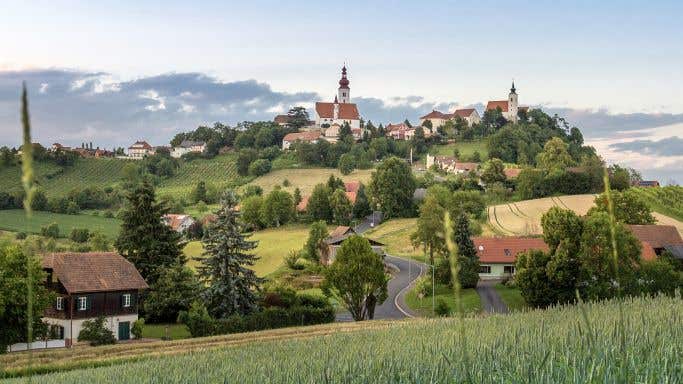Perfectly picnic-ready Austrian white wine, sun-bright, energetic and charming, and starting at €10.99, $21.99, £19.
The table was laden with sliced smoked hams and paprika-spiced sausages, platters of brawn and liverwurst (liver sausage), alpine cheeses, pickled vegetables and crunchy fresh vegetables. A line of wine bottles snaked along the counter, all Austrian, from light, crisp Rieslings to strident Sauvignon Blancs, rich Grüner Veltliners and into an array of Blaufränkisch. But I’d just ridden my bike across half of Brooklyn and it was the first seriously sunny, spring-like day we’d had in a year. The wines were all delicious but the one begging to be drunk with both the food and the weather was Neumeister’s Gemischter Satz, from Styria.
Gemischter Satz is difficult to translate but generally refers to a mixed planting of varieties and therefore to a traditional Austrian wine made from a mixture of grape varieties. It’s most closely associated with Vienna, where it’s a staple in the city’s Heurigen, the ‘wine taverns’ that dot the city’s outskirts. In Vienna, Gemischter Satz is regarded as so essential to the culture that it has its own DAC (Districtus Austria Controllatus, the Austrian appellation of origin system), with the commensurate rules dictating allowed varieties and proportions.
But in fact Gemischter Satz is traditional all over the country – you could probably argue that it was traditional to any country pre-phylloxera, when it was typical to have many different varieties planted in a single vineyard, often at random, as a safeguard against the vagaries of weather and disease.
Indeed, Christoph Neumeister’s family has made a mixed-variety wine from their vines in the Vulkanland, south-eastern Styria (see this World Atlas of Wine map), since long before he took over the estate in 2006. Monika Caha, Neumeister’s importer and the chef responsible for the buffet described above, tells me it was delicious, perfectly suited to the food Neumeister’s family served up in their Buschenschank, the quintessentially Austrian version of a seasonal tasting room which also serves food.
Every winery made a Gemischter Satz, Neumeister tells me, only under a different name in Styria. ‘Especially here in the Vulkanland, where most vineyards were just a part of mixed agriculture, it was the “house wine”, called Mischsatz. The intention was to have lots of varieties with high yield and a few varieties for the taste. Also, it was an insurance to have mixed plantings in case of rot, hail or other troubles. One variety would always make it …’
Neumeister’s Buschenschank is now a rather posh restaurant called Saziani, named for the steep, high vineyard that Neumeister’s grandparents, Rupert and Stefanie, purchased in 1969. And Neumeister’s wines have come a long way since then, too. Neumeister’s 30 ha (74 acres) of vineyards include some of the region’s most hallowed, such as Moarfeitl, Klausen and Steintal, the first classified as a grand cru and the next two as premiers crus by the STK (Steierische Terroir & Klassik Weingüter), a local growers’ association working to define Styrian terroir.
Most of his vineyards are high (340 m/1,115 ft in elevation), with excellent views over the nearby border into Slovenia, and terrifyingly steep, by necessity worked entirely by hand. All have been certified organic since 2013. The chic, state-of-the-art winery uses the hilly topography to its advantage, allowing gravity to move the wines through the winemaking process. Under Christoph’s guidance, Neumeister wines have become some of the region’s most impressive – an impression borne out by the 26 tasting notes we have in our database.
So it’s no surprise that Neumeister’s version of a Mischsatz is so exciting. It’s not a relic, nor a modern wine designed to address a trend; it’s made with the same conscious effort as for all his other wines, crafted to reflect the land he farms. This is in fact the first vintage that he’s put Sarmat on the label, a reference to Sarmat gravel, an Alpine calcareous gravel, dotted with volcanic material, unique to the Vulkanland. The vines it comes from were planted some 50 years ago and comprise a cornucopia of grape varieties (‘25% Goldburger, 20% Müller-Thurgau, 15% Welschriesling, 15% Weissburgunder, 10% Scheurebe, 5% Sylvaner, 3% Traminer, 3% Riesling, and more, even reds like Zweigelt, Sankt Laurent, Blaufränkisch’, Neumeister says). Harvested together and co-fermented in stainless steel, the resulting wine is bright and fresh, floral and fruity, earthy and spicy all at once. There’s a hint of herbs (chamomile, dandelion), a touch of musk, a hint of passion fruit and a streak of zingy citrus; it’s also light on its feet and only 12.5% alcohol yet broad and silky in texture.
It is, in fact, a perfect wine for an upscale Buschenschank – or a chic spring picnic wherever you are. It can take on all manner of charcuterie and won’t blink at the pickles; it loves smoked fish as much as it does herb-laden potato salads. And it’s closed with a screwcap, so you can leave the corkscrew at home and never worry about TCA.
In the UK, Neumeister’s wines are available from Newcomer Wines; in the US, they are distributed by Rosenthal Wine Merchant. You can also locate their distributors throughout Europe and Asia on the Partners tab of the Neumeister site.
Members can find over 300 reviews of Styrian wines in our tasting notes database.



